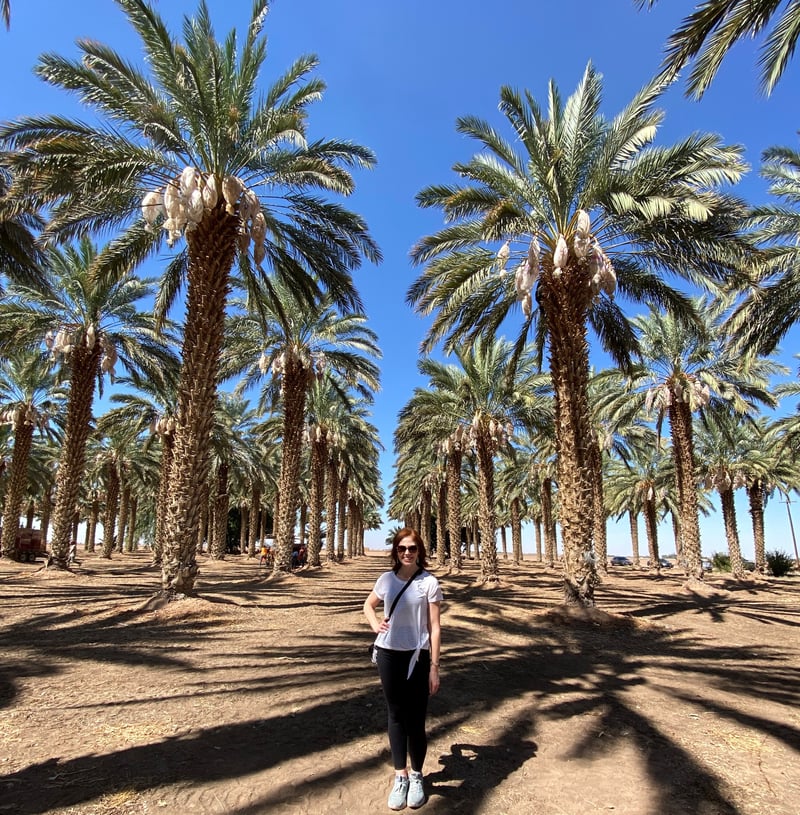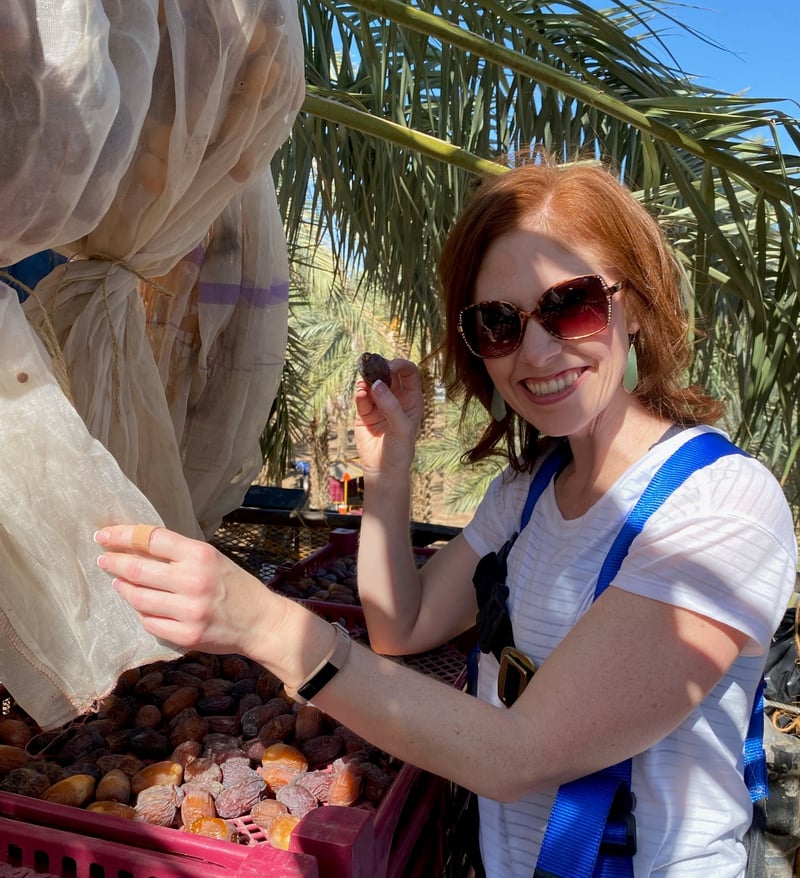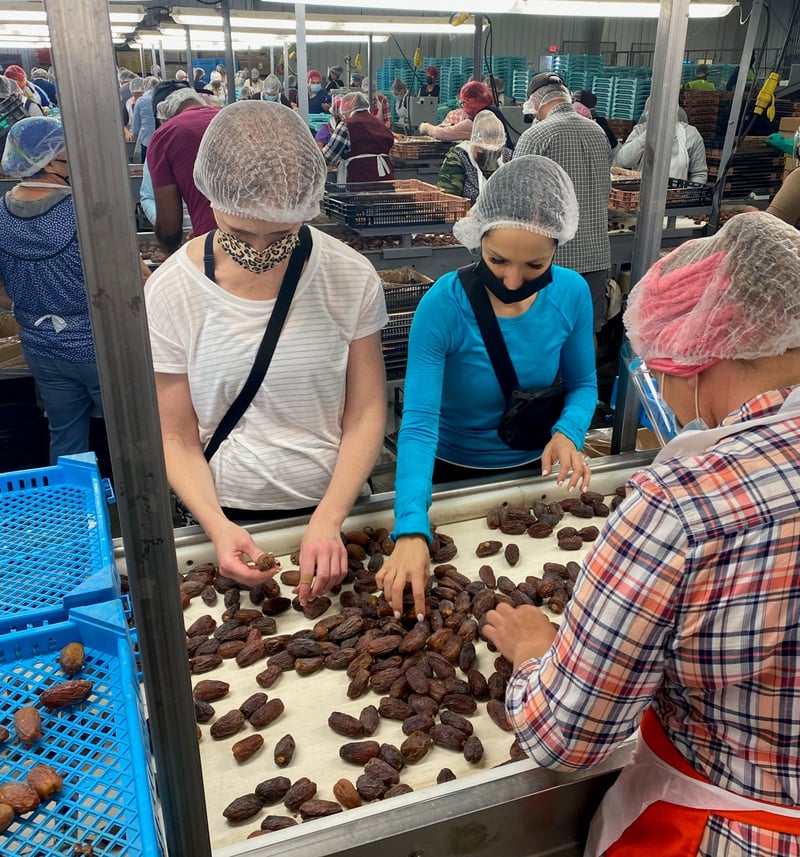As a registered dietitian, when I think about Medjool dates, I think of fiber, antioxidants, vitamins, and minerals! I think about using them to naturally sweeten foods and provide delicious flavor. But what I don’t always think about is how they got to my kitchen.
This year I was fortunate enough to get to experience the Medjool Dates Harvest! And when I say “experience,” I mean EXPERIENCE! If you’re wondering how a date gets to your grocery store, let me give you a quick harvest tour. First, if you did not know this, Medjool dates are grown on palm trees known as Medjool Date Palms. Considering my love for palm trees, these fields took my breath away. Picture rows and rows of beautiful palms full of naturally sweet, delicious dates!

Now if you don’t know a lot about the history of dates, let me give you a few facts to bring you up to speed:
- Dates go back thousands of years. They originated in Morocco and were cultivated in the Middle East and Indus Valley. They came to Southern California in 1944 and a few of the original offshoots still stand tall today!
- 30-34 million pounds of dates are harvested every year in the fall in Bard Valley, CA
- Each Medjool date palm yields approximately 200 pounds of dates, which is around 4,000-5,000 dates a tree.
So, how do these millions of dates get harvested? You wouldn’t believe! Date palms have thorns up and down their trunks (about 800- 1,600 thorns per tree), so they first have to be dethorned. Next, the Medjool Date Palms are hand-pollinated. While there are some ways to mechanically pollinate the flowers, many farmers still take the time to hand pollinate each and every flower on the tree! This begins the growing process. Dates grow on the palms from April through June. In order to protect the dates from birds and wildlife, the fruit arms of the palm are tied up in ventilated bags that still receive sunlight. This ensures that if any dates fall off the limb, they are caught, not wasted.
.jpg?width=800&name=Date%20Picture%202%20(option%201).jpg)
Now, this is where it really gets interesting! To harvest dates, Palmeros go up and down each and every palm to retrieve the dates from the bags. Yes, I said each and every tree! And guess who got to be a Palmero for a day or more like 30 minutes?! Me! After getting a lesson on how to empty date bags and harnessing myself to a lift, I got to go up the palm with an experienced Palmero and harvest Medjool dates! The warm sunshine, stickiness of the dates, and sweet smell was an experience like no other. And you want to know about farm to table? You better believe I tried one of those luscious, sweet dates.

Once dates come off the palms, they go through a meticulous process of sorting and grading. Dates are hand sorted first- some to be immediately packaged to sell, some for date paste, some need to ripen more, and so on. It’s amazing to watch the skill of the workers who have been trained to use their hands and sense of touch to identify if a date is good to go, needs an extra day of sun drying, two days of sun drying, etc. I tried this process as well, and let me tell you, it’s harder than it looks! I looked more like I LOVE LUCY in the chocolate factory episode! But those date graders, they have it down!!! The dates are then finally ready to be packaged and brought to your local grocery store for you to enjoy!

As a registered dietitian, I always find it so interesting to talk to growers because their passion for what they do is like none other! And what’s really amazing is that many of these farms are run by generations of families that care more than you would ever know about providing a delicious, wholesome, safe, nutrient-rich product for you. So, after a few days at the harvest, one thing I can whole-heartedly say: Medjool dates are truly “Raised on Sunshine®,” responsibly harvested and an absolute natural delight at any meal for any eating occasion.
By Amy Goodson, MS, RD, CSSD, LD

Amy Goodson is a registered dietitian and consultant in the Dallas-Fort Worth area with an emphasis on overall health, wellness, and sports nutrition. She is a speaker, spokesperson, and writer and passionate about communicating positive nutrition messages to consumers.
